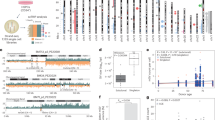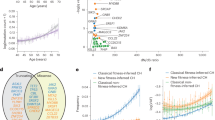Abstract
Osteochondroma, the most common benign bone tumor, may occur as a sporadic lesion or as multiple neoplasms in the context of multiple osteochondromas syndrome. The most severe complication is malignant transformation into peripheral secondary chondrosarcoma. Although both benign conditions have been linked to defects in EXT1 or EXT2 genes, contradictory reports are present in the literature regarding the requirement of their biallelic inactivation for osteochondroma development. A major limitation of these studies is represented by the small number of samples available for the screening. Taking advantage of a large series of tissues, our aim was to contribute to the definition of a genetic model for osteochondromas onset and transformation. EXT genes point mutations and big deletions were analyzed in 64 tissue samples. A double hit was found in 5 out of 35 hereditary cases, 6 out of 16 chondrosarcomas and 2 recurrences; none of the 11 sporadic osteochondromas showed two somatic mutations. Our results clearly indicate that, in most cases, biallelic inactivation of EXT genes does not account for osteochondromas formation; this mechanism should be regarded as a common feature for hereditary osteochondromas transformation and as an event that occurs later in tumor progression of solitary cases. These findings suggest that mechanisms alternative to EXT genetic alteration likely have a role in osteochondromas pathogenesis.
This is a preview of subscription content, access via your institution
Access options
Subscribe to this journal
Receive 50 print issues and online access
$259.00 per year
only $5.18 per issue
Buy this article
- Purchase on Springer Link
- Instant access to full article PDF
Prices may be subject to local taxes which are calculated during checkout
Similar content being viewed by others
Accession codes
References
Bernard MA, Hall CE, Hogue DA, Cole WG, Scott A, Snuggs MB et al. (2001). Diminished levels of the putative tumor suppressor proteins EXT1 and EXT2 in exostosis chondrocytes. Cell Motil Cytoskeleton 48: 149–162.
Bovée JV, Cleton-Jansen AM, Kuipers-Dijkshoorn NJ, van den Broek LJ, Taminiau AH, Cornelisse CJ et al. (1999a). Loss of heterozygosity and DNA ploidy point to a diverging genetic mechanism in the origin of peripheral and central chondrosarcoma. Genes Chrom Cancer 26: 237–246.
Bovée JV, Cleton-Jansen AM, Wuyts W, Caethoven G, Taminiau AH, Bakker E et al. (1999b). EXT-mutation analysis and loss of heterozygosity in sporadic and hereditary osteochondromas and secondary chondrosarcomas. Am J Hum Genet 65: 689–698.
Bridge JA, Nelson M, Orndal C, Bhatia P, Neff JR . (1998). Clonal karyotypic abnormalities of the hereditary multiple exostoses chromosomal loci 8q24.1 (EXT1) and 11p11–12 (EXT2) in patients with sporadic and hereditary osteochondromas. Cancer 82: 1657–1663.
Cheung PK, McCormick C, Crawford BE, Esko JD, Tufaro F, Duncan G . (2001). Etiological point mutations in the hereditary multiple exostoses gene EXT1: a functional analysis of heparan sulfate polymerase activity. Am J Hum Genet 69: 55–66.
Essadki B, Moujtahid M, Lamine A, Fikry T, Essadki O, Zryouil B . (2000). Solitary osteochondroma of the limbs. Clinical review of 76 cases and pathogenic hypothesis. Acta Orthop Belg 66: 146–153.
Farach-Carson MC, Hecht JT, Carson DD . (2005). Heparan sulfate proteoglycans: key players in cartilage biology. Crit Rev Eukaryot Gene Expr 15: 29–48.
Hall CR, Cole WG, Haynes R, Hecht JT . (2002). Reevaluation of a genetic model for the development of exostosis in hereditary multiple exostosis. Am J Med Genet 112: 1–5.
Hameetman L, Szuhai K, Yavas A, Knijnenburg J, van Duin M, van Dekken H et al. (2007). The role of EXT1 in nonhereditary osteochondroma: identification of homozygous deletions. J Natl Cancer Inst 99: 396–406.
Hecht JT, Hogue D, Strong LC, Hansen MF, Blanton SH, Wagner M . (1995). Hereditary multiple exostosis and chondrosarcoma: linkage to chromosome II and loss of heterozygosity for EXT-linked markers on chromosomes II and 8. Am J Hum Genet 56: 1125–1131.
Hennekam RC . (1991). Hereditary multiple exostoses. J Med Genet 28: 262–266.
Huvos AG . (1991). Bone Tumors: Diagnosis, Treatment, and Prognosis, 2nd edn. WB Saunders: Philadelphia.
Jennes I, Pedrini E, Zuntini M, Mordenti M, Balkassmi S, Asteggiano CG et al. (2009). Multiple osteochondromas: mutation update and description of the multiple osteochondromas mutation database (MOdb). Hum Mutat 30: 1620–1627.
Knudson Jr AG . (1971). Mutation and cancer: statistical study of retinoblastoma. Proc Natl Acad Sci USA 68: 820–823.
Lonie L, Porter DE, Fraser M, Cole T, Wise C, Yates L et al. (2006). Determination of the mutation spectrum of the EXT1/EXT2 genes in British Caucasian patients with multiple osteochondromas, and exclusion of six candidate genes in EXT negative cases. Hum Mutat 27: 1160.
Ludecke H-J, Ahn J, Lin X, Hill A, Wagner M J, Schomburg L et al. (1997). Genomic organization and promoter structure of the human EXT1 gene. Genomics 40: 351–354.
McCormick C, Leduc Y, Martindale D, Mattison K, Esford LE, Dyer AP et al. (1998). The putative tumour suppressor EXT1 alters the expression of cell-surface heparan sulfate. Nature Genet 19: 158–161.
McCormick C, Duncan G, Goutsos KT, Tufaro F . (2000). The putative tumor suppressors EXT1 and EXT2 form a stable complex that accumulates in the Golgi apparatus and catalyzes the synthesis of heparan sulfate. Proc Natl Acad Sci USA 97: 668–673.
Mertens F, Rydholm A, Kreicbergs A, Willen H, Jonsson K, Heim S et al. (1994). Loss of chromosome band 8q24 in sporadic osteocartilaginous exostoses. Genes Chromosom Cancer 9: 8–12.
Pedrini E, De Luca A, Valente EM, Maini V, Capponcelli S, Mordenti M et al. (2005). Novel EXT1 and EXT2 mutations identified by DHPLC in Italian patients with multiple osteochondromas. Hum Mutat 26: 280.
Porter DE, Simpson AH . (1999). The neoplastic pathogenesis of solitary and multiple osteochondromas. J Pathol 188: 119–125.
Raskind WH, Conrad EU, Chansky H, Matsushita M . (1995). Loss of heterozygosity in chondrosarcomas for markers linked to hereditary multiple exostoses loci on chromosomes 8 and 11. Am J Hum Genet 56: 1132–1139.
Rohlin A, Wernersson J, Engwall Y, Wiklund L, Björk J, Nordling M . (2009). Parallel sequencing used in detection of mosaic mutations: comparison with four diagnostic DNA screening techniques. Hum Mutat 30: 1012–1020.
Schmale GA, Conrad III EU, Raskind WH . (1994). The natural history of hereditary multiple exostoses. J Bone Joint Surg Am 76: 986–992.
Solomon L . (1964). Hereditary multiple exostosis. Am J Hum Genet 16: 351–363.
Springfield DS, Gebhardt MC, McGuire MH . (1996). Chondrosarcoma: a review. Instr Course Lect 45: 417–424.
Traeger-Synodinos J . (2006). Real-time PCR for prenatal and preimplantation genetic diagnosis of monogenic diseases. Mol Aspects Med 27: 176–191.
Trebicz-Geffen M, Robinson D, Evron Z, Glaser T, Fridkin M, Kollander Y et al. (2008). The molecular and cellular basis of exostosis formation in hereditary multiple exostoses. Int J Exp Pathol 89: 321–331.
Wicklund CL, Pauli RM, Johnston D, Hecht JT . (1995). Natural history study of hereditary multiple exostoses. Am J Med Genet 55: 43–46.
Wu Y-Q, Heutink P, de Vries BBA, Sandkuijl LA, van den Ouweland AM, Niermeijer MF et al. (1994). Assignment of a second locus for multiple exostoses to the pericentromeric region of chromosome 11. Hum Mol Genet 3: 167–171.
Wuyts W, Ramlakhan S, Van Hul W, Hecht JT, van den Ouweland AM, Raskind WH et al. (1995). Refinement of the multiple exostoses locus (EXT2) to a 3-cM interval on chromosome 11. Am J Hum Genet 57: 382–387.
Wuyts W, Van Hul W, De Boulle K, Hendrickx J, Bakker E, Vanhoenacker F et al. (1998). Mutations in the EXT1 and EXT2 genes in hereditary multiple exostoses. Am J Hum Genet 62: 346–354.
Wuyts W, Van Hul W . (2000). Molecular basis of multiple exostoses: mutations in the EXT1 and EXT2 genes. Hum Mutat 15: 220–227.
Acknowledgements
This research was supported by the European Project EuroBoNeT.
Author information
Authors and Affiliations
Corresponding author
Ethics declarations
Competing interests
The authors declare no conflict of interest.
Rights and permissions
About this article
Cite this article
Zuntini, M., Pedrini, E., Parra, A. et al. Genetic models of osteochondroma onset and neoplastic progression: evidence for mechanisms alternative to EXT genes inactivation. Oncogene 29, 3827–3834 (2010). https://doi.org/10.1038/onc.2010.135
Received:
Revised:
Accepted:
Published:
Issue Date:
DOI: https://doi.org/10.1038/onc.2010.135
Keywords
This article is cited by
-
An update on the imaging of diaphyseal aclasis
Skeletal Radiology (2021)
-
Biology of Bone Sarcomas and New Therapeutic Developments
Calcified Tissue International (2018)
-
Cell biology of osteochondromas: Bone morphogenic protein signalling and heparan sulphates
International Orthopaedics (2013)
-
Secondary peripheral chondrosarcoma evolving from osteochondroma as a result of outgrowth of cells with functional EXT
Oncogene (2012)
-
Malignant degeneration of a lumbar osteochondroma into a chondrosarcoma which mimicked a large retropertioneal mass
Skeletal Radiology (2012)



